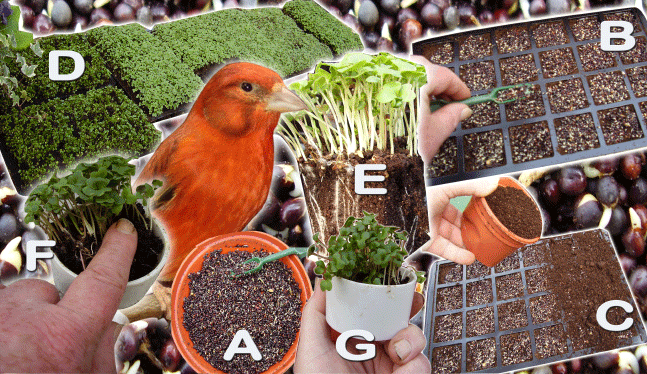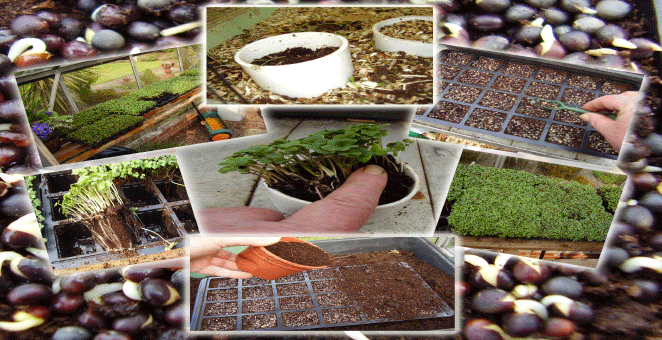Feeding
GROW YOUR OWN GREENFOOD

GATHERING wild greenfood can be a time consuming job and there is always a risk that weeds collected from the wild could be contaminated by herbicides, pesticides or have been fouled by animals. It is much safer growing your own as, then, there is no contamination from outside influences.
Until recently I used to germinate the rape seed that I buy from my bird seed supplier but, this year, my friend, Philip, gave me a sack of rape seed as bought by farmers to sown in their fields. You have probably seen fields, lit up by the bright yellow blossoms of oil seed rape plants.
Philip told me that this seed is readily available from farm shops and that a full sack costs only about £5.00. He also said that because these seeds are not treated, they germinate better than the rape seed that we feed to our birds. How right he was!
I use an 8ft x 6ft greenhouse to grow my rape seed, but a cold frame or small plastic covered shelving system could be used. These systems are cheap and are available from most DIY centres. One I saw recently measured 3 ft wide x 6ft high x 12ins deep. Stood against a sunny wall it is almost as good as a conventional greenhouse for starting seeds – and much cheaper.
First, I place a thin layer of rape seed in the bottom of a shallow dish. I just cover the seed with boiling water and place a piece of card on top. The dish is then placed in the greenhouse for 48 hours. When the card is removed the seed has well chitted.
I bought six plastic planting trays to start with, from my local garden centre for £2.49p. These trays can be used over and over again and will last for years if you look after them. Each tray has 24 planting compartments moulded into it. I fill each pocket with potting compost, firm it down, and spread a thin layer of the chitted seed on top.
Then I cover the seeds with a layer of very fine compost. The tray is watered and placed in the greenhouse. After another 48hours the seedlings will be seen breaking through the top layer of compost. The seedlings must be kept damp so the trays should be watered as required, depending on the weather.
Five to seven days later, the cress-like seed is ready to be used. In all, I use 20 trays for my 40 breeding pairs. I prepare three or four trays every few days, until all the trays are in use and my greenhouse bench is full. In this way, the crop is staggered so that there are always plants at different stages of growth. This means that a continuous crop of fresh cress is available for my birds. This year, the weather was good at the middle of February so I started planting a few trays. By the beginning of March I was able to start giving my birds fresh greenfood every other day to set them on the conditioning cycle to get them ready for the breeding season. Once a tray is empty, I start the process again.
Because of the shape of the growing compartments, the cress can be lifted out with its roots and soil, as a plug.
The plug is pushed firmly into a 3 inch plastic seed dish
The seed dish is then placed in the cage. I use one dish for every two birds. If a bird is in a cage on its own, the plug is split and only half of it is fed.
Growing my own greens in the way described takes only five to 10 minutes per day. This is far quicker than finding a safe source and gathering wild food. It is also fresher as it is still growing when the birds eat it.
All of my birds - linnets, greenfinches, redpolls, bullfinches, goldfinches and canaries - are eating this food. They even eat every root and even seem to like the compost so it could well be that they find trace elements in it.
When I go back into the shed, an hour after putting in the dishes, there is hardly anything left; just traces of compost in the bottom of the dish. It is not quite free, but I certainly consider growing your own rape seed to be a most cost effective way of feeding essential greenfood to birds.
